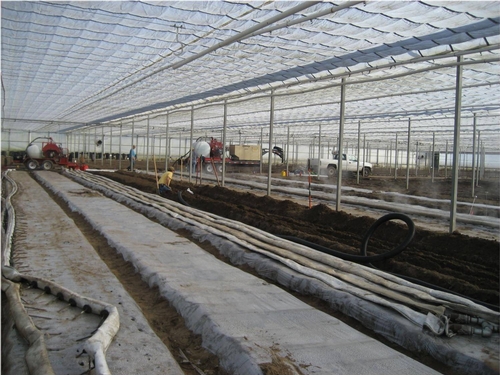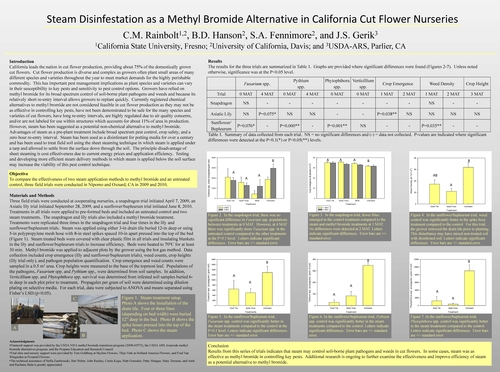Over the last few years, several of my UC Davis, CSU-Fresno, and USDA-ARS collaborators and I have been involved in research related to using steam heat to thermally disinfest soil as an alternative to methyl bromide fumigation. The basic premise of the work is to heat soil to 70C (158F) for about 30 minutes to kill many soil borne pathogens including parasitic nematodes, fungal and bacterial pathogens, and weed propagules (seed and vegetative parts).

It is pretty clear that heat is effective for pest control; however, efficiency (time and fuel) is the biggest sticking point for this to be a viable alternative for a substantial number of growers. Below is a brief write-up and a poster presentation that a graduate student at CSU-Fresno presented at a recent International Research Conference on Methyl Bromide Alternatives and Emission Reductions meeting
Steam disinfestation as a methyl bromide alternative in California cut flower nurseries
C.M. Rainbolt, B.D. Hanson, S.A. Fennimore, and J.S. Gerik
California State University, Fresno; University of California, Davis;
and USDA-ARS, Parlier, CA
Steam may be an effective alternative to methyl bromide in cut flower production in California. Steam has been used as a disinfestant for potting media for over a century. In fields and greenhouses, soil has been treated from the top-down using the sheet steaming technique in which steam is applied under a tarp and settles through the soil. Advantages of steam include broad spectrum pest control and a zero hour re-entry interval. The principle disadvantage of sheet steaming is cost effectiveness due to current energy prices and application efficiency. Testing and developing more efficient, bottom-up steam delivery methods may increase the viability of this non-chemical alternative to methyl bromide. To compare the effectiveness of two steam application methods to methyl bromide and an untreated control, three field trials were conducted in cut flower nurseries near Nipomo and Oxnard, CA in 2009 and 2010.
In general, steam disinfestation using either spike hoses or drain tiles usually provided pest control statistically similar to hot-gas methyl bromide. However, high variability probably masked treatment differences in some cases. Although economic assessment of the treatments comparing flower yield and fuel cost estimates are still needed, steam disinfestation of soil in shallow-rooted crops like cut flowers appears to be a promising methyl bromide alternative. The spike hose and drain tile techniques used here are an improvement over sheet steaming; however, additional gains in thermal efficiency (fuel efficiency and heat retention) and a more mechanized application system is needed before steam is used on a significant portion of California’s cut flower nursery acreage.

This work and related projects conducted in cut flower nurseries, strawberry, organic raspberries, orchard replanting and other cropping systems has been funded by USDA-CSREES-MBT, Propane Education and Research Council, California Almond Board, USEPA Region 9, and the USDA-ARS Pacific Area-wide Program for Integrated Methyl Bromide Alternatives.
A full writeup on this project and summaries of many methyl bromide alternatives research projects are available at http://www.mbao.org .
Attached Files: